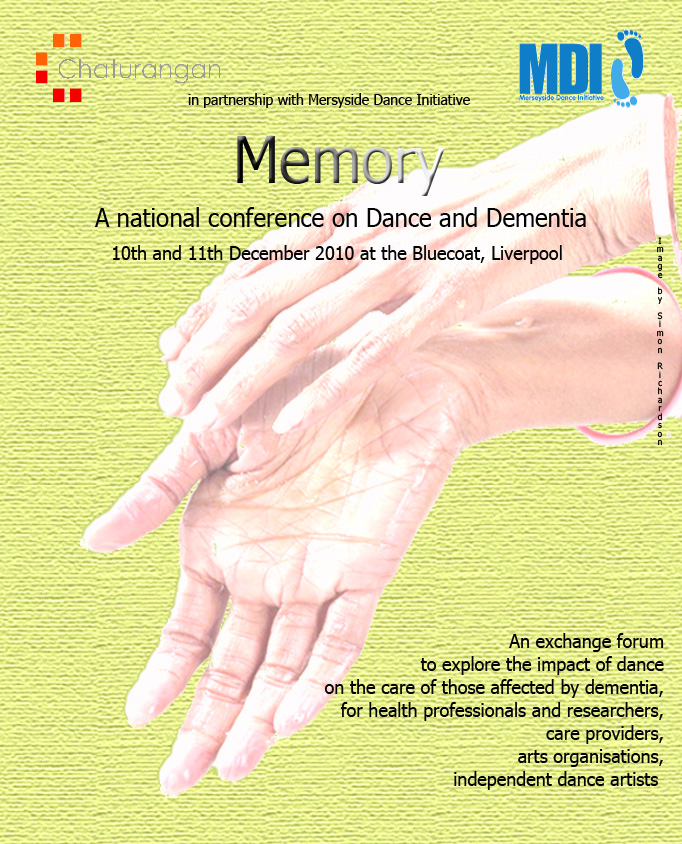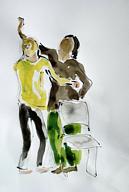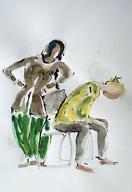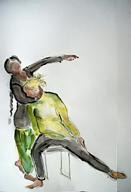|
|
|


Comments
from participant Hannah Lefeuvre
These thoughts about the conference from Hannah at given in full here,
and have also been appended to the abstracts of each item on the abstracts
page as appropriate.
Over two days, Bishaka Sarker provided a rich and full programme of workshops,
speakers, debates, performances and provocations around the specific area
of dance practice, of working with dementia. Rather than comment on each
item of the conference programme, I have written about elements that offered
a fresh perspective or an important reminder of the scope for work with
the ageing dancer. The full conference was recorded and extracts are available
on the Chatarunghan website: (http://www.chezfred.org.uk/Chat/20101210MemoryConference/index.html).
Thank you to Dance South West for providing funds to help me travel to
Liverpool!
Friday 10th December 2010
National Dementia Strategy – Teresa Jankowska, Liverpool PCT
Teresa spoke of Liverpool’s approach of moving away from the medical
model of the Doctor being the expert, of acknowledging the individual,
who know their own stories best, and listening to these stories.
She talked about Liverpool’s commitment to workforce development
and training (including consultants and therapists) and gaining an increased
understanding of Dementia. She cited examples of identified quality outcomes,
such as ‘a person has the right to contribute to society, even in
later, demented years’. She recognised the ‘bringing into
contact’ that occurs as we come closer to death.
Richard Coaten was a memorable speaker, who’s paper was rooted in
the idea that whilst cognitive function is diminished, emotional intelligence
is not. He talked about the importance of being in the moment and being
emotionally open. Holding a “high quality, free-floating attention”,
supporting identity and personhood. Dementia strips us away to our essence,
it is an expression of humanity. We are building bridges of understanding,
through the lived body. For example, we are building bridges between:
Physco – Soma
Sense – non-sense
Known – not yet known
Thinking – feeling
Meaningless – meaningful
The meeting place is about relationships.
Richard highlighted the Dance Movement Therapy skills that come into
play in this work, including:
• Locating triggers – ways in
• Mirroring – reciprocity – same height / can you accept
difference in otherness?
• Rhythm – neuroscience gives us evidence that rhythm helps
organise principles in our brains
• Music, song and percussion
• Importance of repetition
• Re-membering
• Working through metaphor and symbolism
He also stressed the important of working in pairs, rather than solo
and the need to plan, debrief and prepare well.
Richard referred to the conference image, of two hands, to provoke an
improvisation, by delegates, of one hand dementing, the other supporting.
He linked this to Yung’s theory on compensatory function, ie, that
when one element of the body dements, another compensates. He talked about
our role as supporters / enablers within these two hands.
Richard spoke of a subjective embodied experience and how through dance,
participants can go from a place of low well-being, anxiety and depression,
to a lovely sense of positive wellbeing and the brain being at rest.
He spoke of “creative alertness”, “poetic awareness”
and called the work “embodied, phenomenological and psychological”
He saw the work as remedial rather than curatorial and drew a parallel
between the improvisatory nature of dance and that of a person’s
response to their condition.
John Killick – read several poems that had been written by people
with dementia and emphasised the creative urges and talents of those he
had worked with. As he read these poems, including one about “floating
in the sky, high up above the clouds” and “young people don’t
see true beauty” I felt as though the voices were those of people
that had drifted into a profound place, where the mind starts to shut
down on the day-to-day practicalities and stresses of life and move into
a spiritual awareness. I wondered if there was any research that might
correlate the level of stress / creative outlets against the likelihood
of getting dementia. For example, if a person experiences less stress,
is creatively and spiritually fulfilled in childhood and adulthood, are
they less likely to ‘dement’ and is dementia a degenerative
condition or a regenerative condition? A moving back to what is important,
coming full circle – more in touch with one’s spirituality
and a profound thinking, in preparation for death / another life? Experiencing
rich South Asian dance in Liverpool, I was reminded of what this culture
and philosophy can offer to our perspective on dance in later years.
“It’s a licence to be free to be me...I think when I got the
diagnosis...I wanted to find out if I was artistic. Being able to think
outside of the box. It’s a nice feeling.”
“I’d rather be a creature of the air than the earth.”
“Why cry when you can laugh? It doesn’t cost anything”
Killick spoke of his dream – a work with dementia to include contributions
and collaborations from all art forms.
References:
• “I’m still here” (Book) – the gifts of
alzeimers
• www.dementiapositive.com (John Killick and Kate Allen)
• John referred to Tom Kitwood and Faith Gibson, who talks about
how dementia strips people down. Frees them to be creative. Communicate
with greater authenticity.
Diane Amans (notes)
• What is important? What is likely to lead to a positive experience?
• Playfulness – Liberman (Educationalist) says that a truly
playful person has a rich resource of coping strategies and that playful
encounters are important in all aspects of life.
• Wellbeing and dementia is about being able to engage with people.
Our own inner child is open and free. Confident and at ease. Spontaneous
and immediate.
• Lures to invite people to respond: a giant balloon – clocking
reactions, Occupational Therapist played the violin and they moved together,
Rock and roll music
• Partner dancing is ideal
• Non-verbal communication works well – verbal directions
can cause anxiety.
• Author Oliver James talks about feeling good and not knowing why
Fergus Early – observations
• One to one work is ideal - picking up on signals
• Multi-sensory input - touch, words, putting elements together
• Cultural appropriateness – research people’s backgrounds
– triggers
• Sometimes the work can bypass the diagnosis
• Greater attention span in dance
Azucena Guzman
Azucena talked about her research in Psychomotor dance, using Dazon music
and dance. Her research is interested in non-pharmological interventions
(such as dance) before pharmological. Although this was an incredibly
engaging presentation, grounded in sound academic research, I took few
notes. I have requested a copy of her slides (azucena.guzman@newcastle.ac.uk).
I will forward these on when I receive them.
Saturday 11th December 2010
Francois Matarraso opened day two with his reflections on the conference
so far, drawing parallels between his impression of the work on day one
and his interaction with his son in his early, pre-verbal years. Francois
acknowledged Community Dancers’ sensitivity and their ability to
say the unsaid. Whilst Art is always about relationships, he felt that
it was more than that in this context – about a communion –
a shared commitment and values. He referred to Richard Coaten’s
term, re-membering, of being a member of a community again: that’s
what remembering is. He talked about being present in the moment, and
a present being a gift that the practice brings.
Music, Rhythm, Dance and Neuroscience – Julia Clark
A highlight of the conference. Julia gave neuroscientific evidence of
the value of dance and music for dementia. It was a very dense presentation.
Notes from her presentation are listed below, kept in note form, for clarity.
• Everyone is different - we each have a different genetic cross-wiring
in the brain, therefore each dementia is different. This gives justification
for the single case-study approach. The arts can tap into this
• Julia’s case study had Locked-in Syndrome* at 22 yrs old.
She was intellectually intact, but couldn’t move, except her eyes.
The person is there. Can happen after a trauma or stroke. A 1 year into
the condition, the patient could swallow and breath independently. As
the years went by, Julia observed the patient degenerate rapidly.
* A journalist had Locked-in syndrome recently and documented it. If
we go back to medical routes, we can trace it to 1907. Sub-cortal dementias
affect parts of the brain controlling movement, e.g. Parkinsons, Huntingtons,
Motor Neurones. Facial and emotional expression decreased. The cause of
damage is not important, it’s where it is. Starter motor in brain
initiates movement. Loss of brain’s piper rhythm in Locked-in –
unable to initiate movement.
Evolution and use of music
Music therapy can be used to enhance mood. People may forget what you
say, but not how you make them feel. Many types of memory. Examples of
rhythm in nature / everyday lives include:
• Migration, eco-location – e.g. bees, swallows, bats, pod
of whales
• Military cadence – override emotion through rhythm and song.
Energises, motivates, improves posture.
• Rocking child, courtship, ecstasy, anger, battle chant
• Rugby Haka
Music and movement share pathways. Isabel Curran 2006 – A regular
musical beat can be used to replace the piper rhythm – internal
rhythms synchronise and muscles respond to the beat of the music. For
example, clapping – possibly heart beat.
Mozart effect
• Causes dophamine and serotonin to be secreted – diminished
in movement disorders
• Improves space-time reasoning
• The heart is a muscle, therefore it can respond to the music
• Calm music- increases the production of hormone Oxytocin –
the love hormone and reverses the effect of stress hormones
• If Mozart is played during surgery, has been found to resulted
in a better recovery
General notes
• Classical Indian music slows breathing and heart rate.
• Music preference is less effective than pace.
• Repetitive sound meditation – repetitive ohm and keeping
very still has been found to be beneficial. FMRI scan of meditation shows
up a focused attention, increased attention to frontal lobe
• Props – extend your movement and sense of life and self
(amputated self)
• Brain feedback loops – moving, facial muscle – smile.
Milliseconds to change mood – when hear happy music – changed
facial expression
• Non-parametric and parametric tests – I need to look this
one up, as I got a bit confused.
On Fortuitous Novelties – Clive Parkinson
Clive, a designer, spoke about Art, design and sentience and his work
with an artist Darren Browett, creating objects to take into homes. He
spoke of how the objects had provoked conversations, which were beyond
just reminiscence work. These carefully crafted objects were loaded with
meaning. He talked of his own experience with his grandmother and her
requests to constantly come home and his own observations of increased
disinhibition, giving powerful opportunity for creativity.
I loved the tidiness of his work. So much was encompassed in these smooth,
clean, wonderfully crafted objects. Giving opportunity to sit and wonder,
stare, touch and share.
Cohen “arts is like chocolate for the brain. Focuses on assets
and the person. Art allows us to explore taboo ideas e.g. decay and death,
sexuality and mistakes.”
http://darrenbrowett.wordpress.com
http://moma.org/meetme
General thoughts
I gained a lot from conversations in breaks and over dinner, meeting
people with a range of reasons for becoming interested in this work. Overall,
there was a very high standard of speakers and a varied programme. It
was good to focus on such a specific area and practical workshops are
essential.
As a lot of my work is currently with Early Years children, I found masses
of links between the work with young children and people in later years.
I wonder why it is endearing when a child cries, gets upset, thinks laterally
or confuses their words, yet in later years it is seen as a degeneration,
a loss of pride and dignity?
Hannah Lefeuvre, January 2011
|
|





Paintings by
Noelle Williamson
of Bisakha Sarker and Diane Amans rehearsing their piece for this
conference.
|







